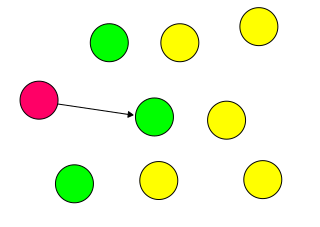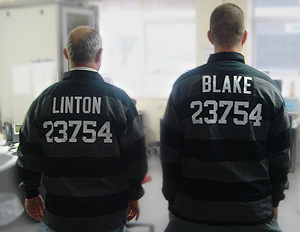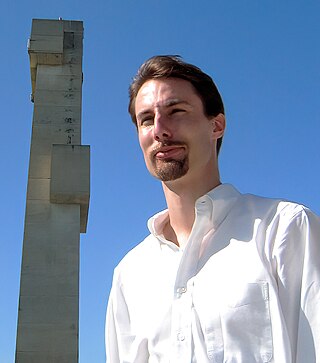Related Research Articles

Internet Protocol version 6 (IPv6) is the most recent version of the Internet Protocol (IP), the communications protocol that provides an identification and location system for computers on networks and routes traffic across the Internet. IPv6 was developed by the Internet Engineering Task Force (IETF) to deal with the long-anticipated problem of IPv4 address exhaustion, and was intended to replace IPv4. In December 1998, IPv6 became a Draft Standard for the IETF, which subsequently ratified it as an Internet Standard on 14 July 2017.
Multiprotocol Label Switching (MPLS) is a routing technique in telecommunications networks that directs data from one node to the next based on labels rather than network addresses. Whereas network addresses identify endpoints, the labels identify established paths between endpoints. MPLS can encapsulate packets of various network protocols, hence the multiprotocol component of the name. MPLS supports a range of access technologies, including T1/E1, ATM, Frame Relay, and DSL.

A router is a computer and networking device that forwards data packets between computer networks, including internetworks such as the global Internet.

Border Gateway Protocol (BGP) is a standardized exterior gateway protocol designed to exchange routing and reachability information among autonomous systems (AS) on the Internet. BGP is classified as a path-vector routing protocol, and it makes routing decisions based on paths, network policies, or rule-sets configured by a network administrator.
The National Science Foundation Network (NSFNET) was a program of coordinated, evolving projects sponsored by the National Science Foundation (NSF) from 1985 to 1995 to promote advanced research and education networking in the United States. The program created several nationwide backbone computer networks in support of these initiatives. It was created to link researchers to the NSF-funded supercomputing centers. Later, with additional public funding and also with private industry partnerships, the network developed into a major part of the Internet backbone.
An autonomous system (AS) is a collection of connected Internet Protocol (IP) routing prefixes under the control of one or more network operators on behalf of a single administrative entity or domain, that presents a common and clearly defined routing policy to the Internet. Each AS is assigned an autonomous system number (ASN), for use in Border Gateway Protocol (BGP) routing. Autonomous System Numbers are assigned to Local Internet Registries (LIRs) and end-user organizations by their respective Regional Internet Registries (RIRs), which in turn receive blocks of ASNs for reassignment from the Internet Assigned Numbers Authority (IANA). The IANA also maintains a registry of ASNs which are reserved for private use.
The North American Network Operators' Group (NANOG) is a forum for the coordination and dissemination of information to backbone/enterprise networking technologies and operational practices. It runs meetings, talks, surveys, and a mailing list for Internet service providers. The main method of communication is the NANOG mailing list, a free mailing list to which anyone may subscribe or post.

Anycast is a network addressing and routing methodology in which a single IP address is shared by devices in multiple locations. Routers direct packets addressed to this destination to the location nearest the sender, using their normal decision-making algorithms, typically the lowest number of BGP network hops. Anycast routing is widely used by content delivery networks such as web and name servers, to bring their content closer to end users.
A route distinguisher is an address qualifier used only within a single internet service provider's Multiprotocol Label Switching (MPLS) network. It is used to distinguish the distinct virtual private network (VPN) routes of separate customers who connect to the provider.

A network operations center, also known as a "network management center", is one or more locations from which network monitoring and control, or network management, is exercised over a computer, telecommunication or satellite network.
BGP hijacking is the illegitimate takeover of groups of IP addresses by corrupting Internet routing tables maintained using the Border Gateway Protocol (BGP).

The Toronto Internet Exchange Community (TorIX) is a not-for-profit Internet Exchange Point (IXP) located in a carrier hotel at 151 Front Street West, Equinix's TR2 data centre at 45 Parliament Street and 905 King Street West in Toronto, Ontario, Canada. As of March 2021, TorIX has 259 unique autonomous systems representing 285 peer connections and peak traffic rates of 1.344 Tbps, making it the largest IXP in Canada. According to Wikipedia's List of Internet Exchange Points by Size, TorIX is the 16th largest IXP in the world in numbers of peers, and 17th in the world in traffic averages. The Exchange is organized and run by industry professionals in voluntary capacity.

The INOC-DBA hotline phone system is a global voice telephony network that connects the network operations centers and security incident response teams of critical Internet infrastructure providers such as backbone carriers, Internet service providers, and Internet exchanges as well as critical individuals within the policy, regulatory, Internet governance, security and vendor communities. It was built by Packet Clearing House in 2001, was publicly announced at NANOG in October 2002, and the secretariat function was transferred from PCH to the Brazilian CERT in 2015.

Bill Woodcock is the executive director of Packet Clearing House, the international organization responsible for providing operational support and security to critical Internet infrastructure, including Internet exchange points and the core of the domain name system; the chairman of the Foundation Council of Quad9; the president of WoodyNet; and the CEO of EcoTruc and EcoRace, companies developing electric vehicle technology for work and motorsport. Bill founded one of the earliest Internet service providers, and is best known for his 1989 development of the anycast routing technique that is now ubiquitous in Internet content distribution networks and the domain name system.
Misuse of a Network Time Protocol (NTP) server ranges from flooding it with traffic or violating the server's access policy or the NTP rules of engagement. One incident was branded NTP vandalism in an open letter from Poul-Henning Kamp to the router manufacturer D-Link in 2006. This term has later been extended by others to retroactively include other incidents. There is, however, no evidence that any of these problems are deliberate vandalism. They are more usually caused by shortsighted or poorly chosen default configurations.
BIRD is an open-source implementation for routing Internet Protocol packets on Unix-like operating systems. It was developed as a school project at the Faculty of Mathematics and Physics, Charles University, Prague, and is distributed under the GNU General Public License.
In networking, a black hole refers to a place in the network where incoming or outgoing traffic is silently discarded, without informing the source that the data did not reach its intended recipient.
Hurricane Electric is a global Internet service provider offering Internet transit, tools, and network applications, as well as data center colocation and hosting services at one location in San Jose, California and two locations in Fremont, California, where the company is based.
Resource Public Key Infrastructure (RPKI), also known as Resource Certification, is a specialized public key infrastructure (PKI) framework to support improved security for the Internet's BGP routing infrastructure.

On October 4, 2021, at 15:39 UTC, the social network Facebook and its subsidiaries, Messenger, Instagram, WhatsApp, Mapillary, and Oculus, became globally unavailable for a period of six to seven hours. The outage also prevented anyone trying to use "Log in with Facebook" from accessing third-party sites. It lasted for 7 hours and 11 minutes.